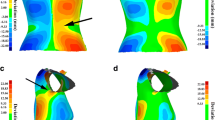Abstract
Purpose
The aim of the study is to evaluate the difference in shape of the upper part and lower part of the Scapulothoracic Gliding Surface (STGS).
Methods
3D-CT images of the thoracic cage of 50 patients were created in MIMICS ®. Three anatomical landmarks (insertion m. serratus anterior on 5th rib; transverse process of 2th and 7th vertebra) were used as an anteroposterior cutting plane to define the STGS. The upper part of the STG was defined as rib 2–5 and the lower part as 5–8. Next, in MATLAB ®, a script was used to create the sphere with best fit for upper and lower parts of STGS. The Root-Square-Mean Error (RSME) (mm) between two closest points on the fitted sphere and the STGS of both parts were calculated to determine the goodness-of-fit.
Results
The RSME was found to be significantly lower for the area ribs 2–5 (mean 7.85 mm, SD 1.86) compared the area of ribs 5–8 (mean 10.08 mm, SD 1.90).
Conclusion
The STGS of the upper thoracic wall (2–5) is more spherical shaped than the STGS of the lower thoracic wall (rib 5–8).







Similar content being viewed by others
References
Bastir M, Garcia Martinez D, Recheis W, Barash A, Coquerelle M, Rios L, Pena-Melian A, Garcia Rio F, O’Higgins P (2013) Differential growth and development of the upper and lower human thorax. PLoS One 8:e75128. https://doi.org/10.1371/journal.pone.0075128
Bolsterlee B, Veeger HE, van der Helm FC (2014) Modelling clavicular and scapular kinematics: from measurement to simulation. Med Biol Eng Comput 52:283–291. https://doi.org/10.1007/s11517-013-1065-2
Charlton IW (2003) A model for prediction of the forces at the glenohumeral join. Proc Inst Mech Eng [H] 220:801–812
De Toledo JM, Loss JF, Janssen TW, Van Der Scheer TW, Alta TD, Willems WJ, Veeger D (2012) Kinematic evaluation of patients with total and reverse shoulder arthroplasty during rehabilitation exercises with different loads. Clin Biomech 27:793–800. https://doi.org/10.1016/j.clinbiomech.2012.04.009
Der Helm FCT (1994) Analysis of the kinematic and dynamic behavior of the shoulder mechanism. J Biomech 27:527–550
Maurel W, Thalmann D (2000) Human upper limb modeling including scapulo-thoracic constraint and joint sinus cones. Comput Graph 24:203–218
Otoshi K, Takegami M, Sekiguchi M, Onishi Y, Yamazaki S, Otani K, Shishido H, Kikuchi S, Konno S (2014) Association between kyphosis and subacromial impingement syndrome: LOHAS study. J Shoulder Elbow Surg 23:e300–e307. https://doi.org/10.1016/j.jse.2014.04.010
Petrov Y (2009) Ellipsoid fit. The Mathworks Inc. https://www.mathworks.com/matlabcentral/fileexchange/24693-ellipsoid-fit. Accessed 1 Sept 2017
Preuschoft H, Schmidt M, Hayama S, Okada M (2003) The influence of three-dimensional movements of the forelimb on the shape of the thorax and its importance for erect body posture. Walk Upright 243:9–24
Seth A, Matias R, Veloso AP, Delp SL (2016) A biomechanical model of the scapulothoracic joint to accurately capture scapular kinematics during shoulder movements. PLoS One 11:e0141028. https://doi.org/10.1371/journal.pone.0141028
Shi X, Cao L, Reed MP, Rupp JD, Hoff CN, Hu J (2014) A statistical human rib cage geometry model accounting for variations by age, sex, stature and body mass index. J Biomech 47:2277–2285. https://doi.org/10.1016/j.jbiomech.2014.04.045
Van der Helm FC (1994) A finite element musculoskeletal model of the shoulder mechanism. J Biomech 27:551–569
Veeger HE, van der Helm FC (2007) Shoulder function: the perfect compromise between mobility and stability. J Biomech 40:2119–2129. https://doi.org/10.1016/j.jbiomech.2006.10.016
Wang Y, Cao L, Bai Z, Reed MP, Rupp JD, Hoff CN, Hu J (2016) A parametric ribcage geometry model accounting for variations among the adult population. J Biomech 49:2791–2798. https://doi.org/10.1016/j.jbiomech.2016.06.020
Wilk KE, Arrigo C (1993) Current concepts in the rehabilitation of the athletic shoulder. J Orthop Sports Phys Ther 18:365–378. https://doi.org/10.2519/jospt.1993.18.1.365
Wu G, van der Helm FCT, Veeger HEJ, Makhsous M, Van Roy P, Anglin C, Nagels J, Karduna AR, McQuade K, Wang XG, Werner FW, Buchholz B (2005) ISB recommendation on definitions of joint coordinate systems of various joints for the reporting of human joint motion—part II: shoulder, elbow, wrist and hand. J Biomech 38:981–992. https://doi.org/10.1016/j.jbiomech.2004.05.042
Acknowledgements
We want to thank Emmanuel Audenaert for his technical support.
Author information
Authors and Affiliations
Contributions
Casier: data collection. De Wilde: protocol/project development. Paquet: data collection and management, data analysis, manuscript writing, and editing. Van Den Broucke: data collection and management, data analysis, and manuscript writing. Van Houcke: data management. Van Tongel: protocol/project development and manuscript writing/editing.
Corresponding author
Ethics declarations
Conflict of interest
No conflict of interest.
Informed consent
Al participants were given informed consent.
Ethical approval
All procedures performed in studies involving human participants were in accordance with the ethical standards of the institutional and/or national research committee and with the 1964 Helsinki declaration and its later amendments or comparable ethical standards.
Additional information
Publisher's Note
Springer Nature remains neutral with regard to jurisdictional claims in published maps and institutional affiliations.
Rights and permissions
About this article
Cite this article
Paquet, T., Van Den Broecke, R., Casier, S. et al. Defining the shape of the scapulothoracic gliding surface. Surg Radiol Anat 41, 1369–1375 (2019). https://doi.org/10.1007/s00276-019-02342-4
Received:
Accepted:
Published:
Issue Date:
DOI: https://doi.org/10.1007/s00276-019-02342-4




